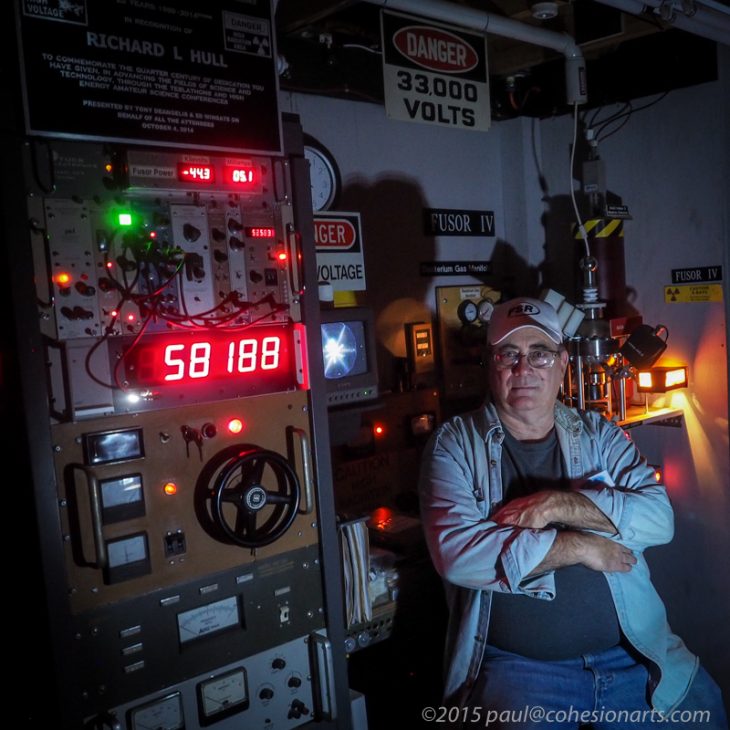… we really are going to need shades…
Imagine being dropped into the middle of an episode of “The Big Bang Theory.” Then imagine taking LSD. Then imagine that the episode runs for like 12 or 14 hours…
Now you’ve got some idea what this past Saturday was like for me…
The occasion was the 26th annual gathering of HEAS – The High Energy Amateur Science group – a loose-nit gang of high voltage, radiation, and fringe science enthusiasts from all over the country who gather at the home and lab of Richard Hull in Richmond Virginia to talk gizmos.
This was my fourth or fifth time attending this event, but even so I felt woefully “out of my league.” I attended because this is the best chance I have every year to visit with the people who inhabit Fusor.net – the site I started back in 1998 to foster discussion among people who are interested in Philo T. Farnsworth’s approach to nuclear fusion.
I felt out of place, but there I was…
I think the tone of the weekend was set early on, when I was chatting with an 18 year old from Seattle named Noah Hoppis, who pulled a small – wait for it – geiger counter! out of his pocket. He proceeded to explain how it works, how he got it, what he does with it, etc.
Noah was there with an older friend of his family, a woman named Linda who lives in the area and was providing transportation for the weekend. I watched as Linda’s eyes glazed over, and at one point she said, “I understand all the individual words, but once he starts stringing them together…. he loses me.”
Which is pretty much how I felt the entire day.
I am at best marginally conversant in these questions of advanced science and physics. Remember, I’m the guy who basically got flunked out of physics in high-school because I was a pain in the ass for the teacher. That was in the 11th grade, and I spent the semester in the principals office pulling wires out of an early kind of computer circuit board. The symbolism is pretty rich…
Despite my failure in any kind of academic scientific pursuit, I have some capacity for staying tuned in long enough to get a sense of the big picture, and maybe even some talent for distilliing the Broad Concepts into language that the average reader can comprehend. I’ve done it in two books, and occasionally somebody will tell me “you said that pretty clearly” or words to that effect. I smile and think to myself, “fooled ‘em again…”
So I spent the first two hours being a million miles – light years? – out of my comfort zone… thinking, “I have no business being here.”
After a few hours of that, I finally settled down and got my camera out and started taking some pictures.
First, here is Richard Hull himself, as his fusor runs on the apparatus around him. Just over his left shoulder is the fusion chamber itself, and over his right shoulder is the video image of the actual “star in a a jar” reaction inside that chamber:
Now, of course, the reaction that Richard has created is pretty “low yield.” 1-2 million neutrons emitted per second may sound like a lot, but that level is safe to be in the same room with. Exponentially, that yield is expressed as 1x10E6 (1 times ten-to-the-sixth) “Breakeven” for a system like this is predicted to occur somewhere between 10E12 and 10E14. Let me do the math: that would be somewhere between 10 and 100 TRILLION neutrons per second. We ain’t there yet.
But fear not. Here’s my favorite single photo of the weekend:
This is Scott Moroch and Jack Rosky, two students at a high school in Wayne New Jersey who are building – yes – their ow nuclear fusion reactor. What Scott is holding in his hand is a model of the fusion chamber they plan to build that they rendered in a 3D printer. The model is plastic, the real thing will be stainless steel (and considerably larger). Now THAT’s using new technology to create new technology…
Finally, my favorite demonstration of the weekend:
….where in Robert Tubbs looks on and assists as Dr. Kevin Dunn from the Hampton-Sidney College in Virginia demonstrates a form of “Caveman Chemistry” – namely a prehistoric chemical process called “fire.”
Conducted in the presence of the Fusor, it’s an intriguing juxtaposition of “Fire Version One” with “Fire Version 2.” Kevin made the point that “civilization” essentially begins with the discovery and control of “Fire v1.0” What becomes of “civilization” if/when we finally control “Fire v2.0”?
And, not surprisingly, it is no easy feat to make fire from two pieces of wood. It takes some coordination to rapidly and repeatedly pull the bow back and forth to spin the spindle while pressing the spindle down against the second piece of wood. It takes a bit of practice and perseverance to get the hang of it.
Watching these young guys try their hand at making fire – and knowing that they would go home to resume their efforts to build and operate a fusion reactor, I came up with this new rule: You’re not aloud to make “nuclear fire” until you have demonstrated that you are capable of making “carbon fire.”
You know, first things first…




